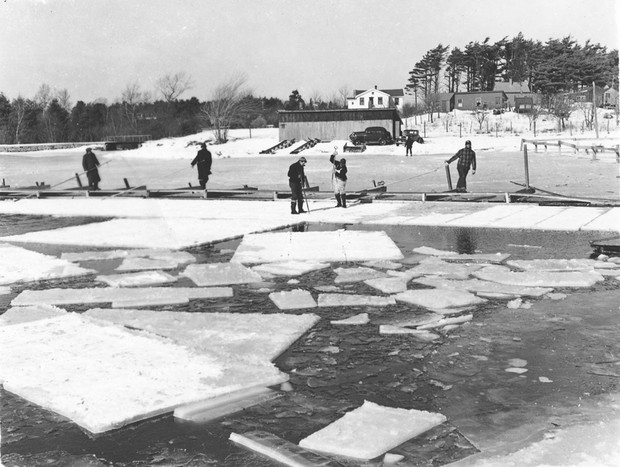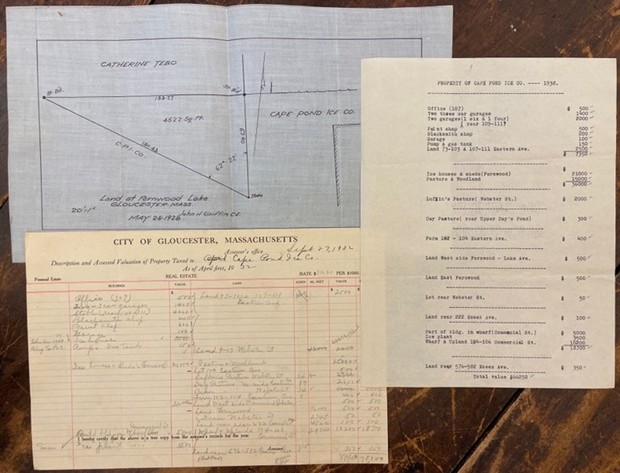Cape Pond Ice Company Archival Collection
By Nancy Ryan, CAM Library & Archives Volunteer
Cape Ann enjoys a rich and diverse commercial and industrial history: art colonies, granite quarries, and the fisheries. To this list, we can add ice-making. A newly acquired archival collection called the Cape Pond Ice Company Collection donated by present owner and local businessman, Scott Memhard, captures the 165-year old partnership of ice-making and fishing that flourished up through the 1970s and 1980s in Gloucester, Manchester, Rockport and Magnolia.

Ice cutting on Fernwood Lake, Gloucester, MA, February 12, 1939. Photograph by William Allen Strople. Collection of the Cape Ann Museum, Gloucester, MA. Gift of Ellen Nelson.
Blacksmith Nathaniel Webster dammed a local brook in 1848, created Webster Pond and built his first icehouse. He saw that the fishing industry was growing rapidly and moved to monopolize ice-making for the fishing industry. Webster and his son Nathaniel, Jr. were the first of five families to own and manage what became known as the Cape Pond Ice Company, taking its name from Cape Pond in Rockport.
Natural ice-making in the ponds and lakes of Cape Ann lasted until the late 1940s when it was replaced with mechanical refrigeration—the modern technology of electricity and ammonia—replacing what Mother Nature did for free. Workers used long hand saws to cut pond or lake ice into strips (a good quality ice was 12” thick or more), then scraped off the surface snow and cut the strips into blocks. These were hauled by horse-drawn wagons to storage in the ice houses, where cork, sawdust, and salt marsh hay were used as insulation. At one time, the natural ice-making business employed large crews of men and boys—more than forty-five—to harvest, store and deliver ice around Cape Ann.

Items from the Cape Pond Ice Company Collection including blueprints and listings of assets. Collection of the Cape Ann Museum Library & Archives, Gloucester, MA. Gift of Scott Memhard, 2021 [Acc. #2021.009].
The manuscript collection of the Cape Pond Ice Company, considered an historic business in Gloucester, is a collection of papers organized chronologically by the five family groups that created, owned, and managed what became known as the Cape Pond Ice Company. It began in 1848 with Nathaniel R. Webster and continued with his son Nathaniel, Jr. (Series I). William and Francis W. Homans, brothers, followed in 1876 (Series II). Freeman H. Abbot and family (Series III) assumed ownership in 1916 and John Ryan, his son Jack Ryan and John Ryan’s son-in-law, Jack Hodges from 1941 to 1982 (Series IV). The fifth family, Dick and his son Scott Memhard with son Larry Memhard took over the business in 1983, and Scott Memhard is the present owner. The collection ends in 1990.
The collection includes blueprints, land surveys, numerous deeds of property, warrants, and mortgages for parcels of land, as well as copies of photographs and company stock purchase and sale. The bulk of the documents relate, firstly, to the invention and patent in the 1950s by John Ryan (Series IV), who also owned Gloucester Ice and Cold Storage on the Gloucester State Pier, of a method of treating (dehydrating) fish and the resulting product used in some instances for the manufacture of cat and dog food. Included are the diagrams and specifications for the equipment that John Ryan invented for the treatment of fish. Secondly, there are numerous documents supporting the transfer / survey / purchase / sale / mortgage of land in Gloucester, Magnolia, Manchester, and Rockport from one company (Cape Pond Ice Company or others) or one individual(s) to others throughout the Company’s 165-year history.
Reliable modern freon ice machines and chillers now provide the preservation needed by fishing vessels and fish processors. Traditional ice-making and ice-harvesting no longer have a place in Gloucester’s business world, but the historical records in CAM’s archives attest to the essential relationship that existed since the mid-1840s between fishing and entrepreneurial five families who responded to the need for fish preservation.